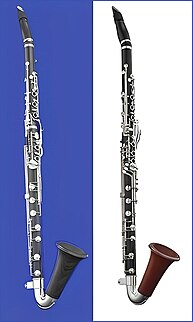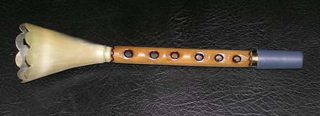
The ganurags (from Latvian: "shepherd's horn") is a Latvian folk clarinet with a cylindrical wooden body onto which an animal-horn bell is attached to amplify the sound. [1] Key systems were added to the instrument in the 20th century. [2]

The ganurags (from Latvian: "shepherd's horn") is a Latvian folk clarinet with a cylindrical wooden body onto which an animal-horn bell is attached to amplify the sound. [1] Key systems were added to the instrument in the 20th century. [2]

The clarinet is a family of woodwind instruments. It has a single-reed mouthpiece, a straight, cylindrical tube with an almost cylindrical bore, and a flared bell. A person who plays a clarinet is called a clarinetist.

A musical ensemble, also known as a music group or musical group, is a group of people who perform instrumental or vocal music, with the ensemble typically known by a distinct name. Some music ensembles consist solely of instruments, such as the jazz quartet or the orchestra. Other music ensembles consist solely of singers, such as choirs and doo wop groups. In both popular music and classical music, there are ensembles in which both instrumentalists and singers perform, such as the rock band or the Baroque chamber group for basso continuo and one or more singers. In classical music, trios or quartets either blend the sounds of musical instrument families or group together instruments from the same instrument family, such as string ensembles or wind ensembles. Some ensembles blend the sounds of a variety of instrument families, such as the orchestra, which uses a string section, brass instruments, woodwinds and percussion instruments, or the concert band, which uses brass, woodwinds and percussion.

A transposing instrument is a musical instrument for which music notation is not written at concert pitch. For example, playing a written middle C on a transposing instrument produces a pitch other than middle C; that sounding pitch identifies the interval of transposition when describing the instrument. Playing a written C on clarinet or soprano saxophone produces a concert B♭, so these are referred to as B♭ instruments. Providing transposed music for these instruments is a convention of musical notation. The instruments do not transpose the music, rather their music is written at a transposed pitch.
Johann Christoph Denner was a German woodwind instrument maker of the Baroque era, to whom the invention of the clarinet is attributed.
A bass musical instrument produces tones in the low-pitched range C4- C2. Basses belong to different families of instruments and can cover a wide range of musical roles. Since producing low pitches usually requires a long air column or string, the string and wind bass instruments are usually the largest instruments in their families or instrument classes.

The chalumeau is a single-reed woodwind instrument of the late baroque and early classical eras. The chalumeau is a folk instrument that is the predecessor to the modern-day clarinet. It has a cylindrical bore with eight tone holes and a broad mouthpiece with a single heteroglot reed made of cane. Similar to the clarinet, the chalumeau overblows a twelfth.

The basset horn is a member of the clarinet family of musical instruments.
A sextet is a formation containing exactly six members. The former term is commonly associated with vocal ensembles or musical instrument groups, but can be applied to any situation where six similar or related objects are considered a single unit.

A soprano clarinet is a clarinet that occupies a higher position, both in pitch and in popularity, than subsequent additions to the family such as the basset horn and bass clarinet. The B♭ clarinet is by far the most common type of clarinet and the unmodified word clarinet usually refers to this instrument. However, due to a tendency for writers and historians to imitate the terms used to denote instruments in other instrumental 'family groups' the term soprano is sometimes used to apply not only to the B♭ clarinet but also to the clarinets in A and C, sounding respectively a semitone lower and a whole tone higher than the B♭ instrument, and even the low G clarinet—rare in Western music but popular in the folk music of Turkey—sounding a whole tone lower than the A. While some writers reserve a separate category of sopranino clarinets for the E♭ and D clarinets, those are more usually regarded as soprano clarinets as well. All have a written range from the E below middle C to about the C three octaves above middle C, with the sounding pitches determined by the particular instrument's transposition.

The zhaleika, also known as bryolka (брёлка), is the Slavic wind instrument, most used in Belarussian, Russian and sometimes Ukrainian ethnic music. Also known as a "folk clarinet" or hornpipe. The zhaleika was eventually incorporated into the balalaika band, the Hungarian tarogato, and may have contributed to the development of the chalumeau, a predecessor of the clarinet.
The alto clarinet is a woodwind instrument of the clarinet family. It is a transposing instrument pitched in the key of E♭, though instruments in F have been made. In size it lies between the soprano clarinet and the bass clarinet. It bears a greater resemblance to the bass clarinet in that it typically has a straight body, but a curved neck and bell made of metal. All-metal alto clarinets also exist. In appearance it strongly resembles the basset horn, but usually differs in three respects: it is pitched a whole step lower, it lacks an extended lower range, and it has a wider bore than many basset horns.

Buffet Crampon SAS is a French manufacturer of wind instruments based in Mantes-la-Ville, Yvelines department. The company is the world market leader in the production of clarinets of the Boehm system. Its subsidiary, Buffet Crampon Deutschland GmbH, founded in 2010 and based in Markneukirchen, Vogtland, Sachsen, is the world market leader in the manufacture of brass instruments. To manufacture and sell its products, the BC Group employed around 1000 people worldwide at the beginning of 2021, 470 of them as employees of BC Germany alone. The management of the group has been in the hands of Jérôme Perrod since 2014.
The willow flute, also known as sallow flute, is a Nordic folk flute, or whistle, consisting of a simple tube with a transverse fipple mouthpiece and no finger holes. The mouthpiece is typically constructed by inserting a grooved plug into one end of the tube, and cutting an edged opening in the tube a short distance away from the plug.
English Folk Song Suite is one of English composer Ralph Vaughan Williams' most famous works. It was first published for the military band as Folk Song Suite and its premiere was given at Kneller Hall on 4 July 1923, conducted by Lt Hector Adkins. The piece was then arranged for full orchestra in 1924 by Vaughan Williams' student Gordon Jacob and published as English Folk Song Suite. The piece was later arranged for British-style brass band in 1956 by Frank Wright and published as English Folk Songs Suite. All three versions were published by Boosey & Hawkes; note the use of three different titles for the three different versions.
The Second Suite in F for Military Band is Gustav Holst's second and last suite for concert band. Although performed less frequently than the First Suite in E♭, it is still a staple of the band repertoire. The Second Suite, written in 1911 and first published in 1922, dedicated to James Causley Windram, is longer and considered more difficult to play than its sister suite.

The clarinet family is a musical instrument family including the well-known B♭ clarinet, the bass clarinet, the slightly less familiar E♭ and A clarinets and other clarinets.
Johann Heinrich Wilhelm Grenser was a German musical instrument maker.
A woodwind doubler is a musician who can play two or more instruments from the six woodwind families or other folk or ethnic woodwind instruments, and can play more than one instrument during a performance. A player who plays two instruments from the same family is also often considered a woodwind doubler, but is usually paid less than a player who plays instruments from different families.
The tungehorn is a woodwind instrument used in traditional Norwegian music, which has a single-reed attached to a conical cow or goat horn.